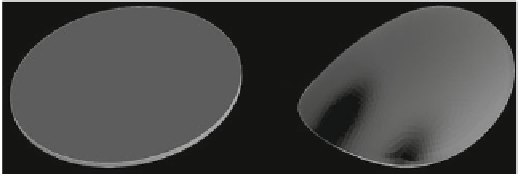Biomedical Engineering Reference
In-Depth Information
Fig. 1
Modeling of myocardium by deforming a plate according to the heart curvature
2.1.2 Element Type
Simulations were performed with the commercial code Abaqus/CAE (Dassault Sys-
tèmes Simulia Corp., RI, USA). Abaqus offers different element types for structural
problems. Since the response of the scaffolds are bending dominated special elements
had to be selected. Standard linear hexahedral elements appear to be inappropriate;
instead the linear formulation with incompatible mode was used (C3D8I) which
yields accurate displacement and stress fields. In a test case four elements were used
over the thickness to compare the finite element solution to an analytical solution of a
clamped beam. Stress was normalized to the analytical solution and calculated to be
0.982 at the fixed support (C3D8I). For quadratic hexahedral elements, normalized
stress was determined to be 0.995, and is equal for reduced and full integration for-
mulations (C3D20R and C3D20). Increasing the element quantity about eight times
(C3D8I
ₒ
0.991; C3D20R & C3D20
ₒ
0.999) and also about 35 times (C3D8I
ₒ
0.995; C3D20R&C3D20
1) lead to minor improvements in accuracy. Evaluating
the normalized tip displacement gives similar results. Since linear elements are less
costly in calculations and the element C3D8I has a comparable accuracy to quadratic
element types, the linear type is preferable. Furthermore, complex structures can be
discretized with a finer mesh without extending the calculation time using linear
elements as compared with quadratic elements.
ₒ
2.1.3 Assembly
Two scenarios were considered: a surgeon manually deforming a flat scaffold ac-
cording to the heart curvature and an already preformed scaffold sewn onto the
myocardium. These modeling ideas were briefly introduced by Bauer et al. but are
presented here in more detail [
25
].
The scaffold is positioned onto the myocardium and single nodes are constrained
to avoid its translation and rotation, as shown in Fig.
2
a. It is assumed that surgeons
use their thumbs to deform the scaffold; therefore, thumb models are positioned onto
the scaffold (Fig.
2
b). 'Thumbs' are modeled to be equidistant and perpendicular to
the myocardium. The scaffold is deformed in two steps as displayed in Fig.
2
c, d.







